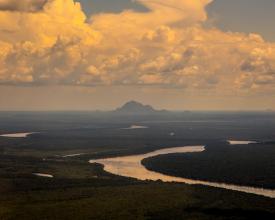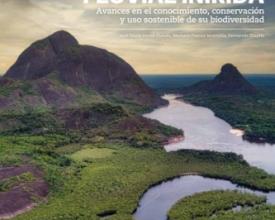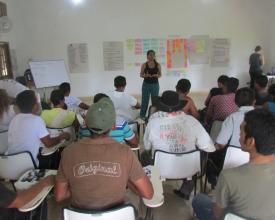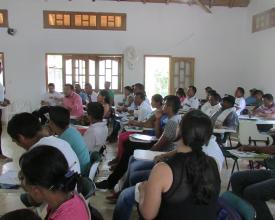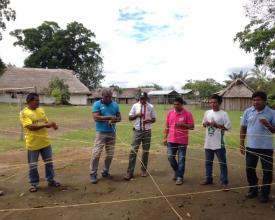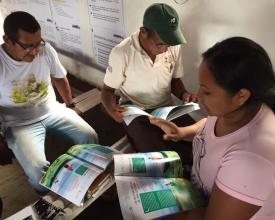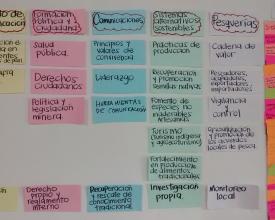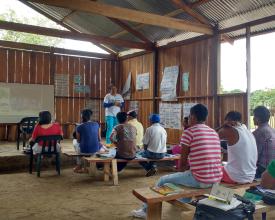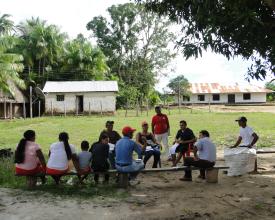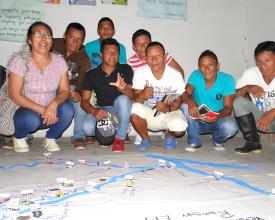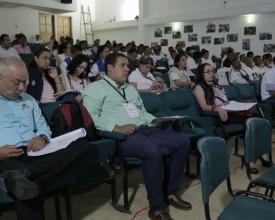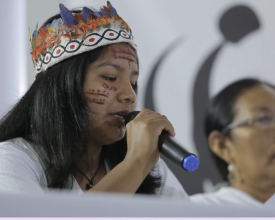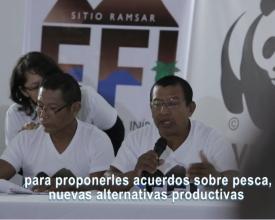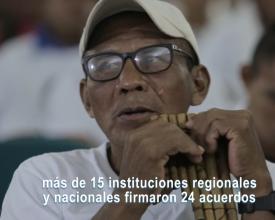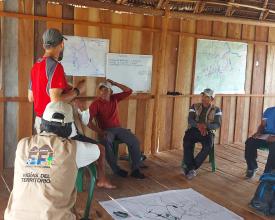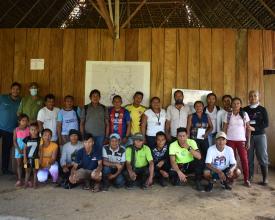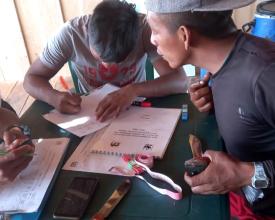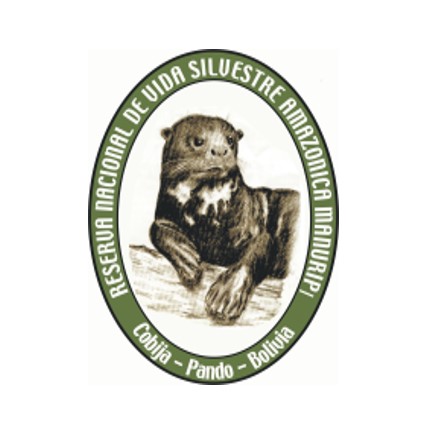
Citizen Action Conversation: an example of territorial governance in the Inírida Fluvial Star Ramsar Wetland -EFI
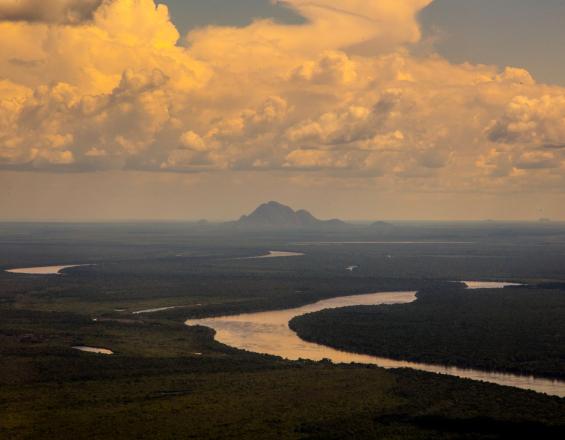
The Citizen Action Dialogue developed at the Ramsar EFI site is a participatory tool under Colombian law and seeks to establish a consensus and fair dialogue between local and institutional actors and reach agreements on priority issues of the territory. In the preparation of the discussion, the capacities of indigenous people and peasants that make up the local Ramsar Bureau were strengthened, providing greater clarity regarding the context of the area. This process concluded with the signing of 24 binding agreements between the Ramsar Bureau and those convened, establishing a joint agenda for the verification of compliance and feedback of the agreements.
The discussion is a successful example of territorial governance, where the agreements between stakeholders and the Ramsar Bureau were aligned with the Environmental Management Plan, as well as with the management and monitoring agendas.
Contexte
Défis à relever
- The lack of qualification in the use of legal and public policy instruments and the low knowledge of the value of participation and collective work, in addition to the little knowledge of the functions of local leaders and indigenous authorities, affects the capacity to influence conflict resolution through dialogue, consensus-building and negotiation.
- The lack of articulation between actors in the territory makes it difficult to agree on common objectives and actions.
- The non-recognition of the threats and vulnerability of fish and wildlife resources affects the survival of indigenous and peasant communities and the ecological dynamics of the Ramsar site.
- The lack of understanding of the value chains of natural resources prevents the effective development of sustainable alternatives in the territory.
- The non-inclusion of traditional knowledge in collective decision-making affects local economic development.
Emplacement
Traiter
Résumé du processus
The implementation of the organized process of comprehensive and interdisciplinary training allowed the Mesa Ramsar collective to strengthen their capacities and skills and to have conceptual and methodological tools aimed at leading a space for dialogue with institutions, unions, territorial, environmental and indigenous authorities on the priorities for the implementation of joint actions for the conservation and sustainable use of biodiversity and cultural traditions. Each step of the process was essential in the generation of trust on the part of the collective and among the participants, feeling and being on equal terms to negotiate interests with other actors, achieving agreements that contribute to the fulfillment of the conservation objective of the Environmental Management Plan of the Ramsar site.
Blocs de construction
Context recognition
The recognition of the context and identification of problems and needs in environmental, social and political terms, was carried out through a planning space using playfulness and community participation where points of view were expressed about what affects the territory, culture and survival, consolidating an exercise of rights for inclusive citizen participation in which the values, customs, traditions and knowledge of indigenous and peasants who inhabit the Ramsar site were incorporated.
Facteurs favorables
- Visibilize the territory from its biological and cultural richness.
- Participation of indigenous and peasant men and women leaders of the Ramsar EFI site in the activities of contextualization and prioritization of problems to be solved.
Leçon apprise
- The joint contextualization of the territory, social, environmental and economic dynamics was an exercise that helped to identify and prioritize the environmental issues that would be worked on in the participatory process of the Citizen Action Forum at the Ramsar EFI site.
- The collaborative processes between stakeholders of the territory contributed to have different views of a context and contribute to creativity in the search for solutions to conflicts in the territory.
- Strengthening and installation of local capacity for future processes.
- Community leaders learned and adopted other perspectives to visualize the territory, its context and problems, adding political, economic and biological elements and understanding how by integrating other knowledge they can better understand the search for shared solutions.
Strengthening decision making
Identification and prioritization of a work agenda with leaders of the Ramsar Bureau for the prioritization of thematic axes, methodologies and operability of the training agenda aimed at ensuring commitments that allowed changes and/or maintenance over time of the environmental and cultural heritage of the Ramsar site. During a year and a half itinerant meetings were held in the Ramsar site, where indigenous leaders and authorities along with farmers interacted with specialists on issues of citizen participation, conservation biology, fisheries management and productive alternatives for life.
Facteurs favorables
- Availability of stakeholders in the construction of the joint agenda between ethnic-territorial authorities, leaders and institutions.
- Participation of the Ramsar Bureau (indigenous and peasants) in the strengthening process,
- Strengthening of relations between indigenous authorities of the Ramsar site.
- Qualification of local actors as political subjects for citizen participation.
Leçon apprise
- Recognizing that strengthening processes are built jointly, generating trust and increasing interest in participation by local stakeholders.
- The reduction of power asymmetries through accompaniment in capacity building processes.
Understanding and appropriation of information
Empowerment of the actors in carrying out actions aimed at achieving a change in realities that contributed to the improvement of their context and quality of life. It was developed during the strengthening process and its maturity boosted the security and confidence of the participants, as part of their leadership for collective decision making within the framework of the implementation of the Citizen Action Conversatory.
Facteurs favorables
- Understanding of the context and the different ways of solving environmental problems by the collective.
- Use of instruments and mechanisms for citizen action provided by the Political Constitution of Colombia.
- Local installed capacity for participation and territorial advocacy in the Ramsar EFI site.
Leçon apprise
To understand that the democratization of information is an essential factor for collective participation and the transformation of local realities with political, social and environmental impact, reducing power asymmetries by accompanying capacity building processes.
Interaction, articulation and generation of agreements
The development of a previously defined structure of roles, moments and instances created an environment of dialogue between the invited person, who is a representative of the public institution with decision-making capacity, and the questioner, a community leader who represents the voice of the communities. The questioner asks the question previously contextualized in the specific problem and proposes the agreement, gives space for the conversation with the guest who proposes alternatives and negotiates with the leader and finally, commits or not generating an agreement.
Facteurs favorables
- Confidence of the collective in the use of dialogue as a mechanism to agree on joint actions.
- Participation response by those invited to the dialogue proposed by the Ramsar Bureau.
- Establishment of a space for dialogue and signing of agreements.
Leçon apprise
- Adaptation by institutional actors to inclusive participation mechanisms where they are called to generate dialogues and agreements based on their competencies and duties with the territory and the collectives.
- The Mesa Ramsar collective recognized that through an organized and qualified process it is possible to agree on actions with local institutions to advance in the achievement of common objectives that benefit all.
Monitoring and evaluation
Definition of an agenda for the verification of compliance and feedback of agreements. The implementation of monitoring and evaluation began with the signing of the agreements and the creation of the monitoring committee from the Ramsar Bureau, this committee is responsible for ensuring and managing compliance with the endorsed agreements.
Facteurs favorables
- The 24 signed agreements that define work agendas for follow-up, evaluation and feedback to define new priorities.
- Establishment of the management and follow-up committee.
Leçon apprise
- For the Ramsar Bureau it has been a permanent learning process to prioritize actions and generate agendas for the management and monitoring of agreements.
- Undoubtedly the greatest learning has to do with the local and national staging of the Mesa Ramsar collective and the recognition acquired as a spokesperson for the conservation, management and sustainable use of the resources of the Ramsar site.
Impacts
- A group of 70 indigenous leaders and farm owners strengthened in citizen participation in the search for solutions to environmental problems.
- 24 agreements signed between indigenous people, farmers and local, regional and national institutions for the conservation and sustainable use of natural resources.
- Recognition by stakeholders of the Ramsar Bureau as the body for dialogue, discussion, consensus building and decision making in the management of environmental problems and conflicts of the Ramsar EFI site.
- A capacity building program implemented for the qualification of leaders.
- Strategic alliances of the Ramsar Bureau with different actors for the strengthening of management, research and local empowerment processes.
- A follow-up and monitoring plan for the 24 agreements, built jointly among the stakeholders.
- Strengthening of the territorial governance process that integrates indicators of the governance component of the Green List, achieving concerted solutions, based on the management tool between the actors and stakeholders in the conserved area of the Ramsar site Estrella Fluvial Inírida-EFI.
Bénéficiaires
1012 indigenous and peasant families of the Ramsar EFI site benefit from the visibility of their territory, the recognition of their participation in decision making and the orientation of shared actions with the competent institutions.
Objectifs de développement durable
Histoire
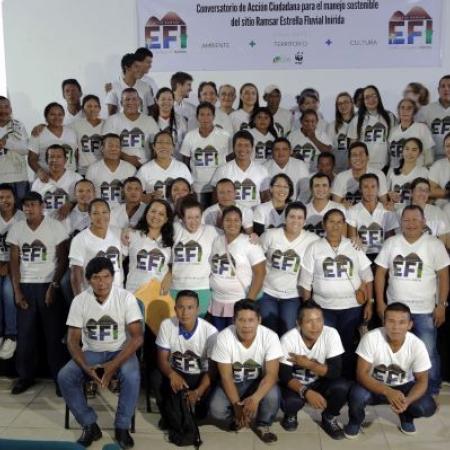
The designation of the Estrella Fluvial Inírida (EFI) as a Ramsar site in 2014, generated the need to articulate actors, interests and actions to guide the implementation of the Environmental Management Plan of the Ramsar EFI site. Due to this, in 2016 the Ramsar Bureau convened a territorial governance exercise where it was proposed to carry out a Citizen Action Conversatory as a participatory mechanism, based on the enforceability of collective citizen rights and materialized through legal and public policy mechanisms for effective participation and advocacy. The Conversatory was developed in three phases: 1. Preparation, 2. Negotiation and 3.
The first phase, which lasted a year and a half, identified the needs, issues and methodologies to make the territory, its biological, hydrological and cultural wealth visible in 15 workshops of four days each.
The second phase took place in one day and was developed under a defined structure of roles, moments and instances; open to the public, with 17 institutions convened, 12 community questioners and the Public Ministry as guarantor, the result of this phase was the signing of 24 binding agreements on three topics: strengthening of self-government and peasant organization, sustainable livelihoods and fisheries management.
The last phase, is being developed from 2017 to date and has a monitoring committee led by the Ramsar Bureau that represents the voice of the indigenous and peasant communities. Its function is to ensure compliance with the agreements under the powers that the constitution and the law offer to citizens.
The discussion has been a successful example of territorial governance since the agreements generated between the multiple stakeholders and the Ramsar Bureau were under the guidelines of the Environmental Management Plan, institutional roles and competencies were identified and strengthened for the implementation of actions, and agendas for management and monitoring were jointly projected.

